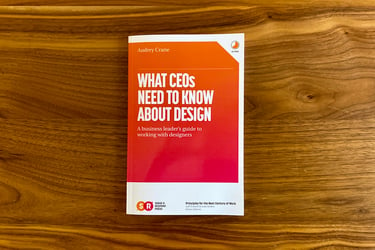We’re living in a gold rush.
In Q1 of 2021, over $125 billion in global venture capital flooded the market. Companies of all sizes – from early-stage startups to fast-growing unicorns to publicly-traded enterprises – were clamoring to build newer, more innovative digital products to capitalize on our increasingly digitized behaviors. As a result, UX design & innovation is in high demand.
If you’re looking to build a UX team, chances are you’re already feeling the frantic energy of this rush. Maybe you’re a product leader looking to drive adoption. Maybe you’re a UX team of one looking to grow your team. Or maybe you’re a forward-thinking executive trying to put customer experience at the forefront.
Whatever the case, you know that building an elite UX team is crucial.
The problem? It’s not a simple task.
UX designers are in high demand and short supply. And even if you manage to attract the right talent, that’s still no guarantee you’ll succeed. There’re questions of design culture. Team structure. And perhaps most importantly, ensuring your entire organization understands the value of great design.
As Co-founder and Partner at DesignMap, I’ve had the opportunity to work with a lot of successful UX teams. I’ve helped several B2B software companies use design to reach or further entrench their status as $1B+ unicorns.
So today, I’m going to teach you the lessons I’ve learned about building UX teams. I’ll combine insights I’ve learned over my 25+ years in design with real-life case studies of some of today’s top tech unicorns and enterprises.
By the end of this post, my goal is for you to have the key insight you need to build & structure the UX team that’ll help you design your way to hockey stick growth.
Alright, let’s do this.
Want to jump to a specific section? Use these links.
3 Traits the Best UX Teams Have in Common
What are we trying to accomplish when we build a UX team? What does success actually look like? Let’s take a few minutes to visualize it.
I took a close look at 8 top UX teams - Google, IBM, Slack, Atlassian, Intuit, GitLab, Shopify, and Salesforce - and found they all share 3 characteristics:
They Feel a Passionate Sense of Ownership

A product designer at Intuit working on a user flow.
Talk to virtually any of the product designers in these companies and you’ll find one thing: they’re all passionate about their products. They’re passionate about the problem they’re solving. More than anything else, they’re really passionate about the people using the product they’ve designed.
In all the best UX teams I’ve worked with, the designers aren’t just production artists whose job is to “jazz it up”. They feel like integral parts of the product’s success. They feel a strong sense of ownership over their work, and feel empowered to contribute to the fullest extent of their ability.
This is an important point to internalize because a lot of companies get this wrong. If you treat designers like they’re just a step in the assembly line, you won’t get inspired work. Full stop.
They Collaborate Well With Other Teams
I’ve seen this wonderful phenomenon occur when working with product teams. The designers will get together with the product managers and engineers for a brainstorm. They’ll start off with a story or customer insights from discovery sessions. They’ll open it up for discussion, and then the magic starts happening.
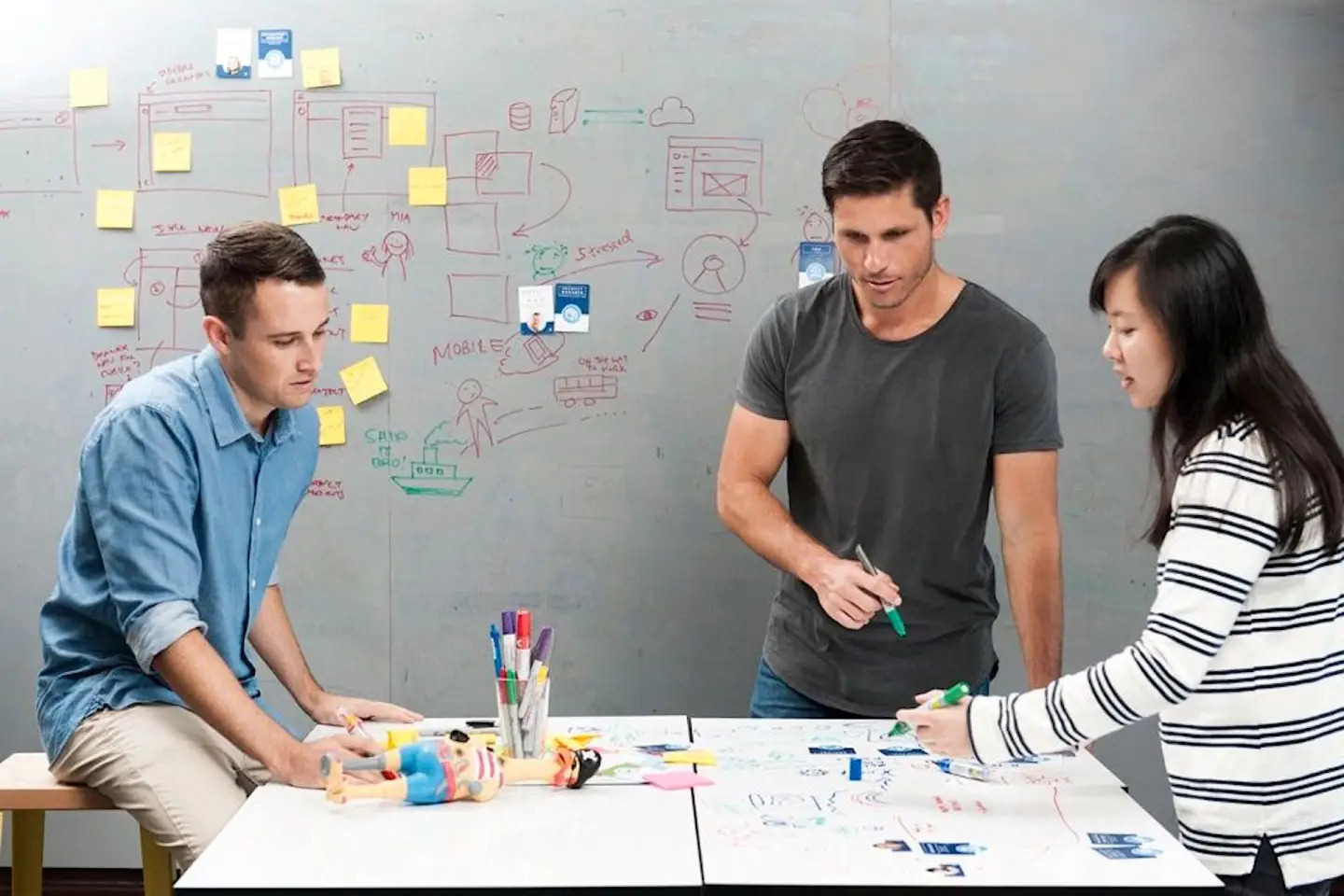
A team at Atlassian engaged in a brainstorming session.
Product managers get everyone excited by detailing the full scope of the business opportunity. The designers align everyone around the users’ pain points by sharing details from interviews. And then the engineers - yes, the engineers - start throwing out product ideas.
That may come as a surprise to you, but engineers can be your best source of innovation. This is something Silicon Valley Product Group’s Marty Cagan talks about in his book Inspired. As the closest ones to the enabling technologies, they’re the ones that can tell you exactly how technologies like NLP or AI/ML, or simulated neural networking can transform your customer’s experience. Take a look at the most disruptive digital innovations from the past decade and I can almost guarantee they started with an engineer.
So why am I talking about engineers? Aren’t we talking about UX teams? Well, yes, we are.
I like to think of UX teams as the stewards of innovation. Their true value doesn’t come from pixels on screens, nor does it come from a small cadre of “genius” designers locked in a studio with custom-designed furniture and expensive espresso machines (unless you’re Apple).
The true value of a UX team comes from collaboration. It comes from empowering cross-functional product teams aided with user-centered design methods, aka Design Thinking. It comes from infecting product managers and engineers with that sense of passionate ownership, and placing the people whose lives are impacted at the heart of every discussion.
The best UX teams collaborate with product managers, engineers, and each other throughout the entire product lifecycle, from start to finish. When Design Thinking leads the way like this, products spend less time in design, less time in development, and ultimately get to market faster and are far more engaging.
They Have a Strong, Supportive & Infectious Design Culture
Whenever I think about design culture, I always think about USAA. They’re in auto insurance - not the first industry we think of when we hear the word “innovation”. But man, this company takes it to a whole nother level.
Starting with their design team, USAA puts the customer experience at the heart of everything they do. Every employee is a customer (they call them “members”), so they get to experience first-hand what the experience is like for non-employee customers. They train employees in Design Thinking, then encourage them to submit ideas to their “Always On Ideas Platform”, which receives over 10,000 submissions each year, 897 of which have been patented. These patented ideas come from all over - one security guard at USAA has 25 U.S. patents to his name!
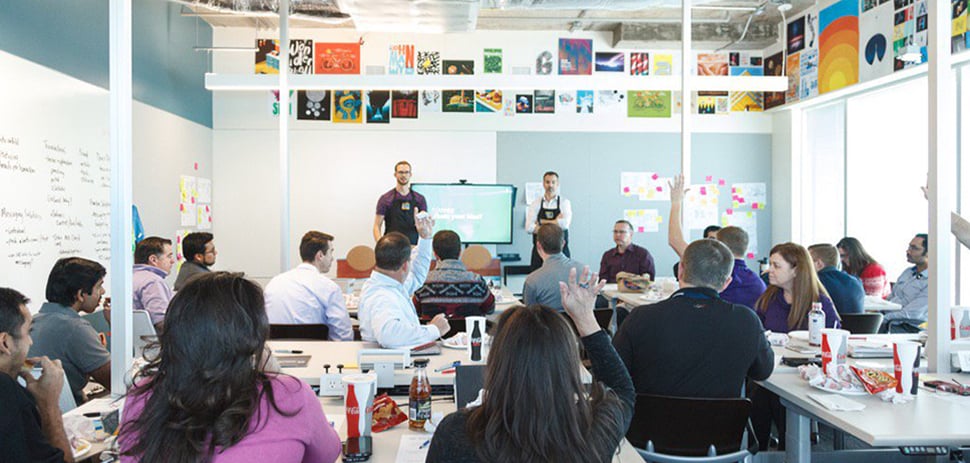
A USAA Design Thinking workshop
This sort of bottom-up innovation is an exceptional example, but it illustrates an important point: when people are encouraged to be curious; when they’re empowered to be creative; when they feel safe to take risks, make mistakes, and share ideas free of judgment, that’s when innovation happens.
The best UX teams create an environment where team members feel supported, learn from each other, and feel free to put themselves out there. You can create this sort of environment too. And if you commit to it, it might infect your entire organization just like it did for USAA.
Building a UX Team: Big Opportunity Means Big Challenges
In the Design Maturity Model, an industry-spanning study of over 2,200 businesses across the globe, Invision found that only 5% of companies have reached the highest level of design maturity where the biggest benefits can be found. This means there’s a tremendous amount of opportunity for companies that reach that level.
It also means it’s really hard to do.

Only 5% of companies achieved the highest level of design maturity according to Invision.
Okay, hope you're as pumped as I am. Now it's time to teach you how to build your product design dream team.
There are 4 big things I'll teach you, starting with...
How to Hire the Best Designers for Your UX Team
I’ve headed up talent acquisition at DesignMap over the last few years, so I can tell you: when it comes to hiring UX designers, it’s a war out there.
Over $125 billion in venture capital hit the market in Q1 of this year. Startups are popping up left and right in virtually every industry, vertical, and niche. Tech giants are investing more in UX than ever before, and traditional enterprises are scrambling to bolster their UX as new disruptive competitors eat into their market share.
In this environment, attracting the right talent is difficult. You might be tempted to rush the process, but that’d be a mistake - making the wrong UX hires can really hurt.
To help you avoid this, let me share how we’ve been able to consistently hire A-players in this crazy competitive market.
The Thing That Most Companies Get Wrong About Hiring UX Designers
In the world of venture-backed startups, you need to show growth. Your investors have given you tens or even hundreds of millions of dollars. They expect you to start growing fast.
With so much pressure, founders can ill afford a mistake. So when it comes to hiring product designers, they play it safe. They look for designers who’ve more or less solved the exact same problem for a different company.
On the surface, this makes total sense. If a designer has the skillset and playbook for solving your problem, that should be a slam dunk, right?
Well, not necessarily. This approach has some big issues.
- It Discourages Adaptive Behavior: the designer feels that they can do the exact same thing they did at their last company, but that’s not true. No matter how many similarities your product or situation shares with their previous company, it’s not the same. Different context. Different company. Different problem. There’s no such thing as a plug-and-play designer.
- Can Lead to Toxic Culture: the designer may feel like they already “know it all”. They may feel entitled to their way of doing things because it worked before so why would they do anything else? This makes for a non-collaborative dynamic.
- .You’ll Gloss Over Qualified Candidates: looking strictly for someone who’s “done it before” means you’ll miss out on a lot of great candidates. On top of that, it can take you even longer to fill the role. Remember, it’s competitive out there.
- You'll End Up with Archetypal Designers: this is also a problem when you hire exclusively from big-name tech firms, but you end up with designers with archetypal experience that all look the same. This hurts innovation. It’s extremely limiting for high growth companies.
Here's what I advise my clients: don't set strict hiring criteria before you start talking with candidates.
Instead, fill the top of your funnel with as many candidates as you can. Go through one round of interviews to see what’s out there, and then get more specific with your hiring criteria.
When it comes to hiring designers, you want unique backgrounds with unique perspectives. Those perspectives—that ability to think outside the box—is what really drives innovation, so see what’s out there before getting hard-and-fast with your hiring criteria.
What’s the Difference Between UX Design and UI Design?
UX design and UI design are two of the three main disciplines in digital product design.
Understandably, there’s a lot of confusion about the difference between them. Let me clear that up.
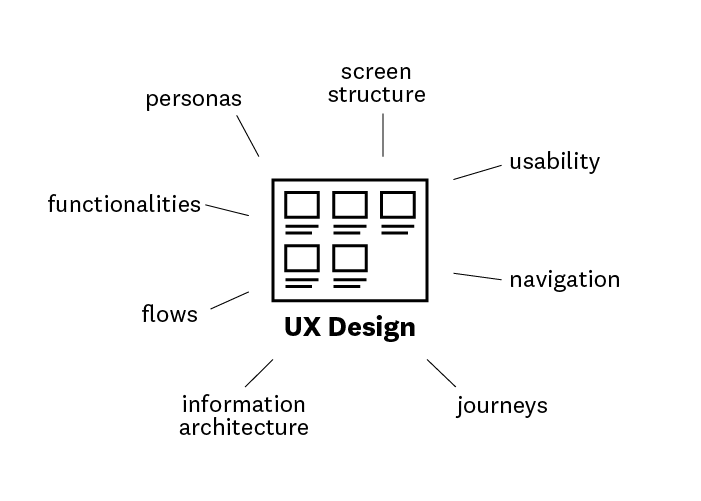
Typical UX design tools include user personas, user journeys, user flows. UX design deals with functionalities, usability, navigation, information architecture and screen structure.
User Experience (UX) Designers are the bedrock of your UX team. These designers are responsible for advocating for your users’ needs throughout the entire product experience, end-to-end. They synthesize an understanding of users’ wants, needs, and pain points to figure out what your product should do and how it should work.
UX designers don’t worry about fonts and colors. Instead, they use tools like user flows, user journey maps, and wireframes to figure out how your product should deliver value to the user.
UX Designers focus on making your product desirable.
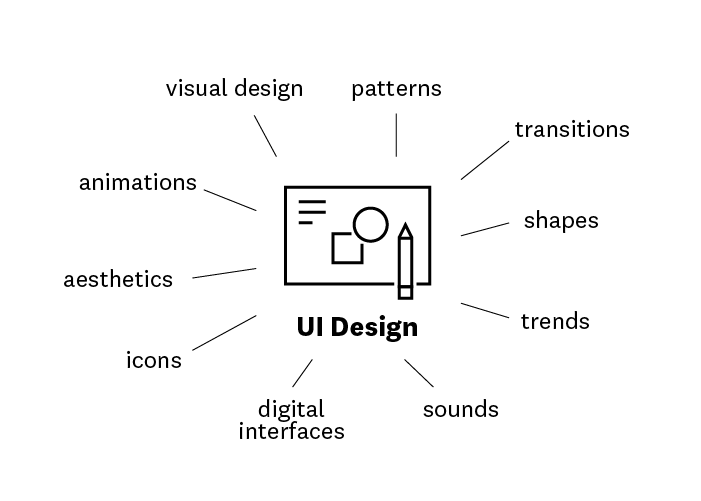
UI designers deal in fonts, patterns, icons, shapes, animations and more.
User Interface (UI) Designers are what everyone thinks of when they think “design”. They use fonts, color schemes, shapes, and patterns to create the visual interface that colors and shapes the user’s experience with your product. It would be a mistake to think UI is just about aesthetics, though.
A UI designer’s job is to make it immediately clear to users what they’re supposed to do. You could have a product that delivers insane value to users, but if they can’t figure out how to use it, it’s all for nothing. A talented UI designer will align themselves around a deep understanding of your user. Then, using the UX designer’s wireframes as guidance, they’ll use visuals to create a user interface that makes the product delightful and easy-to-use.
UI Designers focus on making your product usable.
UX or UI Designer - Which Should You Hire First?
I’d recommend going with a UX designer to start. The reason for this is simple. UX designers focus on what users want. You could have the slickest, most user-friendly interface on the planet, but if your users don’t actually want your product, it doesn’t matter.
Having said that, a good UI is crucial. If you can afford to, try your best to hire both.
Note: UX and UI designers are very different skill sets that require very different perspectives. You might be tempted to hire a generalist product designer who can do both, but I wouldn’t advise it. You’re much better off getting a really good UX designer who can help you create a stellar product experience, then finding a freelancer for the UI.
What Other UX Roles Should You Hire?
The third major product design role is UX Research. I’ll start there.
UX Researchers gather information with user tests, surveys, user interviews, and more to gain a holistic, deep understanding of who your users are and what they want. They build the user personas that guide the work of your UX and UI designers. For any organization wanting to be more user-centric, this role is critical.
Most UX teams don’t start adding dedicated researchers until around their 5th hire. Before that, user research is usually conducted by the UX designers or the PMs.
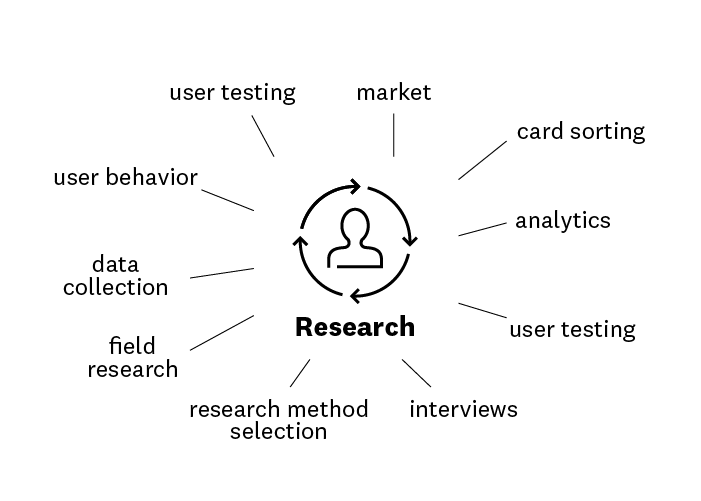
UX researchers use methods like interviews, data studies, and surveys to best understand user goals and pain points.
UX Researchers help you understand your users.
As your UX team scales, your roles will become more specialized. This usually starts with a dedicated UX research team, but soon grows to the following sub-specialties:
- Information Architect: focuses on navigation and information architecture, or how information is arranged in your product.
- Prototyper: builds interactive product prototypes via front-end development or product design software.
- Interaction Designer: while this role can be interchangeable with “UX Designer”, in the more specialized definition they focus on design components and systems and ensuring they work in a consistent manner.
- Content Strategist: handles UX copywriting while also thinking strategically about how voice & tone should contribute to the larger user experience.
- Illustrator / Visual Designer: creates custom UI elements such as icons or character illustrations.
- DesignOps: optimizes processes and tools with the goal of improving the design team’s output and impact.
What Hard Skills Should You Hire For?
This depends on the role you’re hiring for, but it’s important to keep in mind which skills are easily trainable and which skills aren’t. For instance, if a candidate doesn’t know how to run usability tests, that’s fine – you can train them! On the other hand, if their visual design skills are lacking, that’s probably a deal-breaker. You want to hire those skills out of the box.
Atlassian tries to hire T-shaped designers who have some expertise with a broad range of design skills, but have deep expertise in one particular domain. I think this is a pretty good rule of thumb.
What Soft Skills Should You Hire For?
I'd argue that these are the most important skills to hire for, and probably the hardest. The best designers act as facilitators. They empathize with and advocate for the user, and they educate and empower their collaborators. Doing this requires emotional intelligence.
To suss out candidates’ emotional intelligence, here are the characteristics I look for in interviews:
- Self-awareness
- Comfortable with ambiguity
- Skilled at facilitation
- Can be leaders
- Can educate others
- Bring outside perspective
They also need a solid understanding of the design process and can start to imagine how it’d work for your company.
What Process Should You Use to Hire UX Designers?
Glad you asked! We could do a whole post on hiring UX designers, so I’ll quickly summarize.
1. Online Portfolio Assessment: done within 1–2 business days of receipt, we will provide simple feedback and either pass or request an initial interview.
2. Initial Interview: our first touchpoint is typically 1:1 with someone in design leadership position here: a Partner, VP or Director of Design. This usually feels informal, so we can provide honest and direct feedback and get a much better sense of the person behind the portfolio.
3. Second Round Interview: we’ll provide feedback within 1 business day of the initial interview. We’ll invite some back for a second round, which is more formal and typically in a group format. There’ll be 2-4 interviews representing a mix of all design levels from the team they’ll be working with. This is also a chance for them to get a deeper sense of how we go about our work at DesignMap.
4. Candidate Evaluation Form: interviewers submit their evaluation of the candidate via a structured feedback form we send via Lever. We offer a space for their interviewer to share their overall assessment, then score each candidate on a scale of 1-5 on their abilities as well as their culture fit.
How Should You Onboard Your Designers?
At DesignMap, virtually all of our hires are done on a 3 month contract-to-hire basis. Here’s why.
As a Product Strategy & UX Consultancy, our clients expect us to be top notch. Which means our designers need to be top notch.
Even with the best hiring process in the world, a candidate with a dazzling portfolio that aces their interviews still might not be right for the role. Some people are just really good at navigating the hiring process. Those people might not always be right for you.
There’s no better way to assess a candidate than seeing them in action, which is why we always recommend to our clients to do a similar contract-to-hire process.
Having said that, if you’re looking for more specifics, here’s what Atlassian does to onboard designers.
How to Structure Your UX Team
Okay, you’ve got the talent. Next step is to put them in an org structure that’ll help them succeed.
Remember the three things designers need to succeed? Inspired culture, a collaborative team dynamic, and a passionate sense of ownership? Your UX team structure has a huge impact on all three. Team structure can be the difference between a free-flowing team that ships product fast, and a toxic culture that burns designers out.
Obviously you’ll want to avoid the latter. Let’s explore how.
How Do UX Team Structures Work?
Every UX team’s structure falls on a continuum between two extremes: purely centralized and purely decentralized UX teams. I’ll explain the difference.
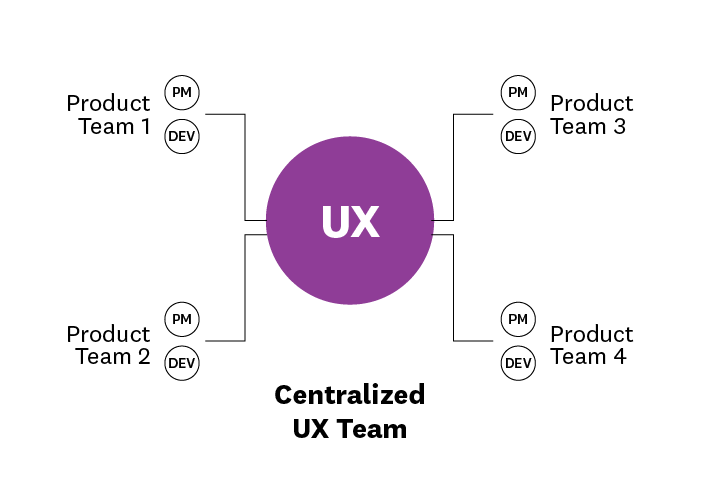
Centralized UX teams operate as an internal agency where UX resources are pooled and drawn upon as needed for projects. Typically, a product manager or whoever else needs design help will put in a request with the UX team leader (could be Design Director, VP of UX, or Chief Design Officer). A designer with the required expertise will then be assigned to the project until a specified completion date, at which time the designer will be returned to the general resource pool.
It’s not uncommon for designers to be working on several projects at once. In fact, we’ve heard cases of designers spending as little as 1/8th of their time assigned to a project.
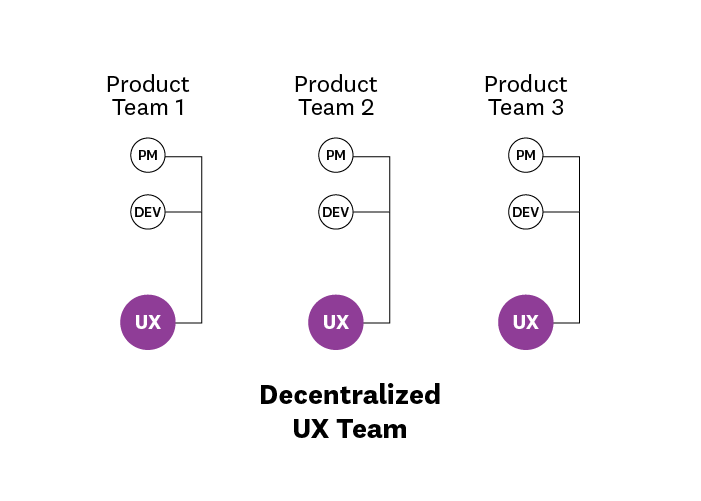
Decentralized UX teams embed product designers on agile product teams along with the engineers and product managers dedicated to a specific product or feature. The entire cross-functional team will work together throughout the entire product lifecycle, from discovery and conception all the way through launch and post-launch.
As organizations grow, the varying disciplines on each product team will report up to a director for their discipline (i.e. Design Director, Product Director, etc.), who will in turn report to a general manager or VP in charge of the business unit.
How Do Top Companies Structure Their UX Teams?
I analyzed the UX team structures of 9 different tech companies (primarily using Invision’s Design Genome Project) to find out. Here’s what I found:

With a few notable exceptions, all of the top UX teams employ a hybrid team structure where designers are embedded on decentralized product teams, but also have a very strong centralized component that acts as a hub for the larger design team.
This centralized hub generally takes one of two forms:
-
Although they work primarily with their product teams, every designer formally sits beneath a design team on the org chart. These designers are likely co-located, and frequently engage in brainstorms, collaborations, fireside chats, etc. Design teams are often organized by product line, and all typically report up to a VP of Design or Chief Design Officer.
-
Most designers formally sit under their product line’s VP or general manager on the org chart. However, there are typically a few centralized design-only teams such as the Design System or DesignOps teams that are shared across the organization. These teams act as the “hub”, coordinating between the product lines to ensure both a cohesive cross-product user experience and sense of community.
If you have the resources for it, a hybrid approach that embeds designers on product teams but still allows for a design-led company culture and cohesive user experience is the best way to go.
How to Build an Inspired UX Team Culture
Understaffed. Overworked. Reeling from office politics.
These are just a few of the maladies that can afflict your designers if your culture isn’t dialed in. But like anyone who frequents SHRM or Harvard Business Review will tell you, avoiding these problems isn’t easy - especially as your UX team scales.
That’s why it’s crucial that you create a safe, inspiring place for your designers. You want them motivated and doing their best work, yes, but even further, you want them to stick around. Turnover’s expensive, and your culture has a huge impact on your ability to attract and retain top designers.
So how do you build an inspired design culture? Let’s dig in.
Create a Psychologically Safe Space
Innovation’s a risky thing. When you think outside the box or try something new, you’re putting yourself out there. You might make a mistake. Your idea might fall flat on its face.
If you’re doing things right, both these things will happen. Frequently.
So if you’re working in a space where your ideas won’t be welcomed - where your coworkers might judge you or your boss might think less of you - you probably won’t take risks. You won’t share ideas, and you won’t think outside the box. You’ll stick with the status quo, because it feels safer.
And if we’re trying to innovate, the status quo is exactly what we don’t want.
Which is why it’s so important to create a sense of psychological safety for your designers. You want them to be freewheeling. You want them to be sharing ideas and riffing off each other. You want them to enter a sort of group flow state where each of them trusts the other, and they feel encouraged to challenge the status quo while others listen with empathy and openness. It’s in these sorts of environments where innovation happens.
Atlassian is one of my favorite examples of a company that puts psychological safety at the heart of their culture. Here’s a company that designed their way from a 2-person startup to a unicorn that IPO’d at over $4B. They did this in 10 years without an internal sales team.
That’s crazy.
To achieve that kind of product-led growth, a strong design culture is an extremely valuable asset, and they have one.
Create a Strong Design Community
A sense of community is crucial. Having spent over 25 years working in design, this is something I can personally attest to. For designers who might spend 75% of their time working with product managers and engineers - people who don’t understand their craft - it’s refreshing to spend time working with other designers.
In fact, if you want the most inspired work, I’d say it’s a requirement.
I’ll use Atlassian again as an example. They invest a ton in building a sense of community around design. They run Town Halls on a weekly basis across the entire design organization, and frequently offer designers the opportunity to get together and exchange ideas.
They have a process called “Sparring” in which designers can request feedback or get help from the team on any project they’re working on.
They even fly their entire design team to their headquarters in Sydney for their annual Design Week conference.
Atlassian’s got a great UX culture to aspire to, but you really don’t need fancy conferences with thought-provoking keynotes. Simply getting the UX team together every week to share work and exchange ideas is a good start. Any team with more than one designer can do this.
Put the Customer at the Center of Everything

Leslie Witt, Head of Design for Intuit’s Small Business Design Group leading a design session.
User experience. Customer centricity. Human-centered design. These are the big buzzwords of the day, and not without good reason.
The companies that are winning today - the ones riding rocketships to multi-billion dollar valuations - are the ones putting the customer experience at the heart of everything they do.
Take a look at Intuit, for example. $166.2 billion market cap. Roughly 10 unique product lines. They just acquired the extremely successful and well-loved Mailchimp for $12B.
Pretty successful company, right?
Well, like anyone who’s used TurboTax or Mailchimp will tell you, Intuit’s products are a delight to use. A big part of how they’ve been able to create such a delightful ecosystem is by putting the customer at the center of their culture.
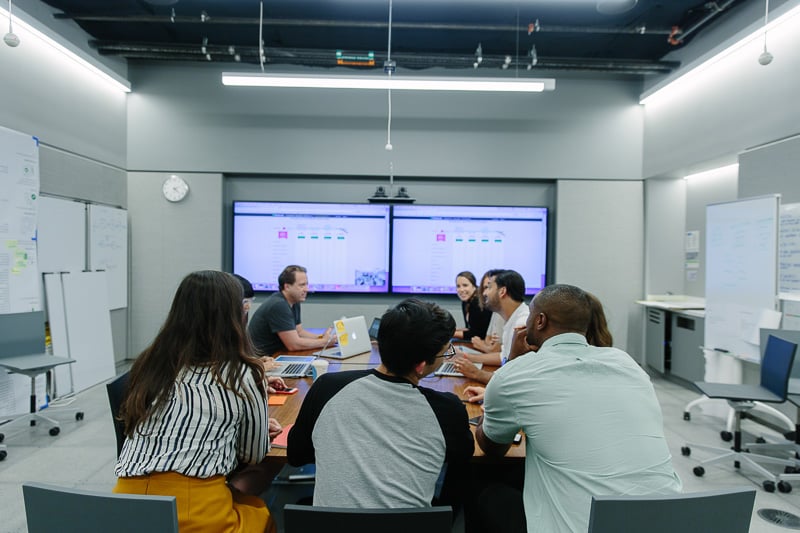
Intuit uses rapid prototyping to quickly gather customer insights and iterate.
They have a series of principles called Design for Delight that guides how they innovate. The first of these principles is Deep Customer Empathy.
Intuit designers will literally follow customers home (with their permission, of course) to observe their behavior trying to solve a problem (i.e. watching a business owner send invoices to customers). They’ll then gather more insights with “Deep Probing Interviews” before synthesizing these insights into statements about the customers’ problems or ideal states.
They then use storytelling to package these insights into a format that’ll bring customers to life and center the entire design team on their experience.
This commitment to customer centricity has been a huge part of their success, and they know it. Their CEO Sasan Goodarzi said that “in order to win, we must be far more customer-obsessed.”
That's something you love to hear from a CEO. I'm excited to see what they come up with next.
How to Get Organizational Buy-In for Your UX Team
Design Thinking has definitely crossed the chasm into the early majority. But for all the adoption we’re seeing across the business world, there are still a ton of people who don’t understand design or its true value.
If I’m being honest, I don’t blame them.
We designers haven’t been good at educating. We haven’t been good at meeting business stakeholders where they are and speaking their language.
To get the buy-in you need for design initiatives - to get the resources you need, and the cooperation of other teams - you’ll need to meet people where they’re at and educate them.
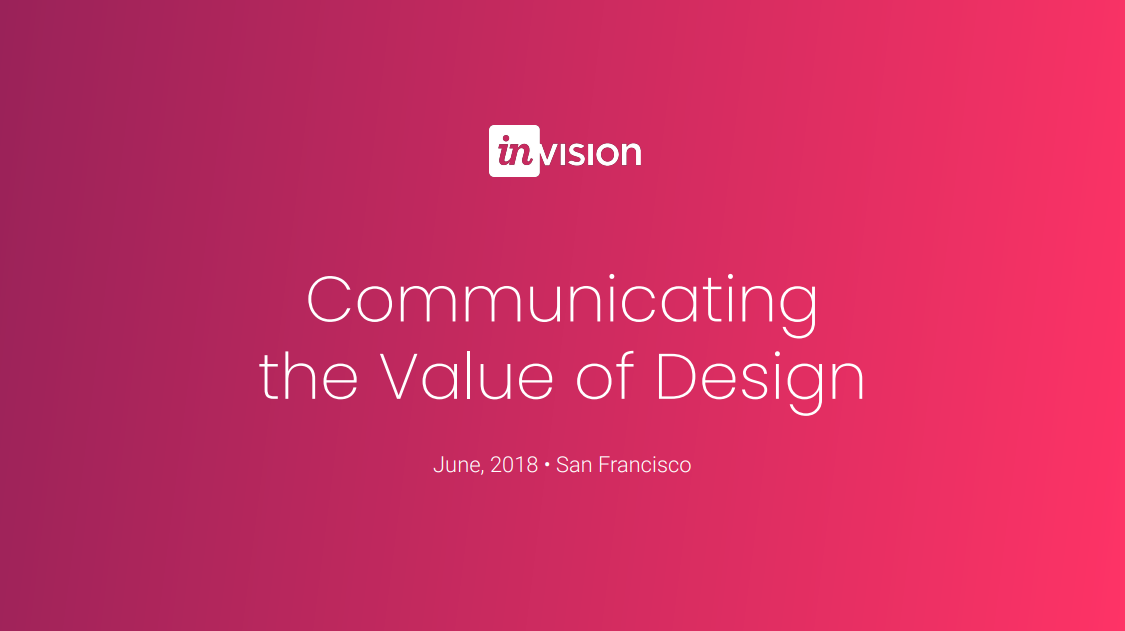
Great presentation from Invision on communicating the value of UX design.
Some years back, we attended a great presentation on this topic by Leah Buley, who was then the Director of Design Education at InVision. She did an amazing job teaching how to build and structure a UX pitch, so we’ll break down the key steps below.
Note: Even if your leadership team has already bought in and given you a budget, this section is still worth a read. Having a compelling way to socialize design’s value across your org will prove crucial for facilitating collaboration across teams. It’ll make your team more visible, too!
Step 1: Gather External Proof Points
There’ve been a ton of studies on the ROI of great product design. These go a long way toward lending your pitch credibility and conveying design’s benefits - especially to executives.
We’ve broken down key proof points for each of design’s numerous benefits in the table below:
| Benefit | Proof Point | Source |
|---|---|---|
| Design makes employees more productive | Employees who use design skills are 47% more productive than the average worker. | UK Design Council Designing a Future Economy Report |
| Design reduces time-to-market | IBM’s Design Thinking practice reduced product design time by 75%, development and testing time by 33%, which ultimately drove a 50% faster time-to-market. | Forrester The Total Economic Impact of IBM’s Design Thinking Practice |
| Companies with the highest level of design maturity had 6x faster time-to-market than companies with the lowest level. | ||
| Design drives innovation | When teams iterate on five or more solutions, they are 50% more likely to launch a product successfully. | IDEO Creative Difference Study |
| The probability of introducing a product innovation is 24% higher in firms where design is integrated. | ||
| Businesses where design is integral are 2x more likely to develop new products and services. |
UK Design Council |
|
| Design increases market share and position | Design-alert businesses increase their market share by an average of 6.3% through design. |
UK Design Council |
| Less than half of design-alert businesses say they compete on price compared to ⅔ of the general population. |
UK Design Council |
|
| Design drives growth | Firms using design as an integrated element have on average a 9.1% higher employment growth rate, an 18.7% higher value added growth rate, and a 10.4% higher productivity growth rate. | |
| Companies with the highest level of design integration drove 32% higher revenue growth than the market average. |
McKinsey |
|
| Investing in design has a high ROI | IBM got a 301% ROI from their design investment over 3 years. | Forrester The Total Economic Impact of IBM’s Design Thinking Practice |
| Design reduces costs | Companies with the highest level of design maturity had 5x higher cost savings than companies with the lowest level. | |
| IBM reduced the number of defects in their products by 50% with Design Thinking, which cut down on maintenance costs. | Forrester The Total Economic Impact of IBM’s Design Thinking Practice |
|
| Design drives higher stock performance & valuation | Companies with the highest level of design integration drove 56% higher returns to their shareholders than the market average. |
McKinsey |
| The stock prices of design-led companies outperformed the S&P 500 by 228% over 10 years. |
Design Management Institute |
|
| Companies with the highest level of design maturity had 26x higher valuations than companies with the lowest level. |
Step 2: Gather Competitive Data
A good way to drive urgency with execs is to show them how much competitors or similar companies are investing in design. Here’s how to do that:
Brainstorm a list of companies to compare with yours
- Pick 4 companies from your list
- Find as much information as you can about their design investment, how important it is to their strategy, how often their CEO talks about it, and what kind of results they attribute to it. To do this, use tools like...
LinkedIn Recruiter Lite: use this tool to find out how many designers the company is employing, and how far up the leadership chain design sits.
Company Websites (if public): public companies offer tons of great information around their investments and initiatives during investor relations days. This info can be found somewhere on their website.
Seeking Alpha (if public): search the company’s earnings for any mention of design or UX.
Step 3: Run a Survey to Gather Internal Data
You may or may not be aware of this, but here’s the truth…
Design is happening, whether you have designers or not.
If your UX resources are insufficient or nonexistent, your product managers or engineers are probably doing design and research work. This isn’t their specialty, it’s taking time away from what they do best, and quite frankly is probably resulting in a bad user experience.
It makes zero sense to pay non-UXers to do UX work.
This is a really compelling point to make in your pitch, so you’ll want to quantify exactly how much your firm’s already paying for design work (in engineering & PM salaries).
At DesignMap, we have our clients run surveys to gather this data. One of our clients found that their product management and engineering teams were spending nearly 59,000 hours and roughly $3 million on UX work each year. That’s more than 28 full-time employees!
To gather this data for your company, follow the following two steps:
-
Run a survey to all the product managers and engineers at your company asking them, “What % of your time do you spend doing design work, aka making decisions about user experience?”
-
Total the hours for each function.
-
Multiply the numbers by each function’s average salary (you’ll have to get this from HR).
Simple as that!
There’s also a good argument to be made for opportunity cost. The client from our example found UX work took up 10% of PM and development teams’ total capacity.
Step 4: Make It Relevant (Context)
Okay, so you’ve got your proof points. You’ve got the data you need to make a rational argument. But as Harvard Professor Gerald Zaltman says, 95% of purchase decision-making is driven by emotion.
So to make your pitch really shine, you’ll need to dial up the emotion. You’ll need to drive urgency, and show your audience that building a UX team is not just a nice-to-have, but is a strategic necessity.
Doing this always comes down to answering this: how will the forces of disruption affect your business? How will disruptive changes in technology, your industry, human behavior, or society-at-large affect the way people interact with your product?
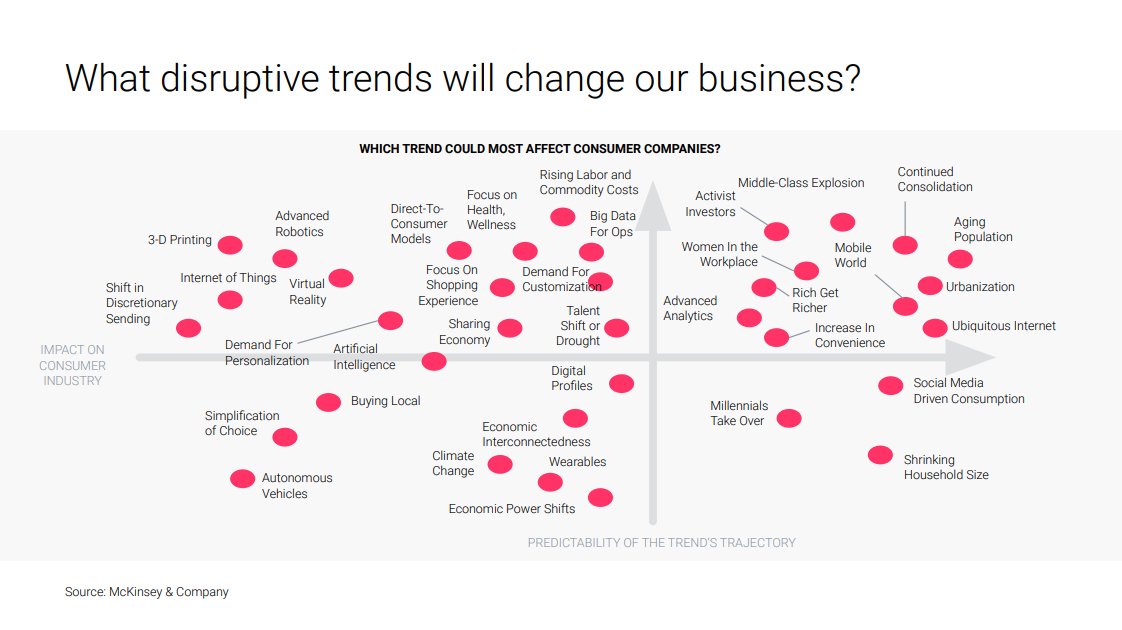
We could probably write a whole post about this, but to start, we recommend you think about what forces or systems affect your product in the ecosystem today, and then think about what trends might disrupt that in the future.
Use this to make a case for why a healthy product design function is crucial to your business’s success.
Step 5: Assemble Your Pitch
Once you’ve gathered all of this information, it’s time to assemble your pitch. Leah recommends this structure:
1. Context: open the pitch with the info you gathered in step 4. Why does design matter? Why is it important that your company builds a UX team now?
2. Competition: how much are your competitors investing in design? Is it an important part of their strategies? This is your data from step 2.
3. Costs: how much is your company spending on design work? How much of this is being done by non-UXers? Data from step 3.
4. Benefits: what sort of ROI might your company get from design? How might it benefit? Include the data from step 1.
5. Recommendations: what steps do you recommend the company take? What resources will you need for your UX team, and why?
Run this pitch past a couple designers or product leaders in your network for feedback. Once you see the heads nodding, you’ll know you’re dialed in and ready to go.
Building a UX Team is a Journey
If you made it to the end of this post, congratulations! That’s no easy feat. Of course, your journey is only just beginning.
Building a UX team is a challenge, but I hope I’ve shown that it can be an incredibly rewarding challenge. As technology continues to dominate our lives and shape our thoughts and behavior more and more, a human-centered approach to product design will only get more important.
After reading this post, my hope is you now have all the information and inspiration to build your product design dream team. If you run into any snags though, feel free to reach out. We’re always inspired to hear from entrepreneurs, designers, and product leaders who are doing big things.
Now it's time for you to build that next unicorn. So on behalf of all the staff here at DesignMap, best of luck building your UX team. We’re rooting for you!

